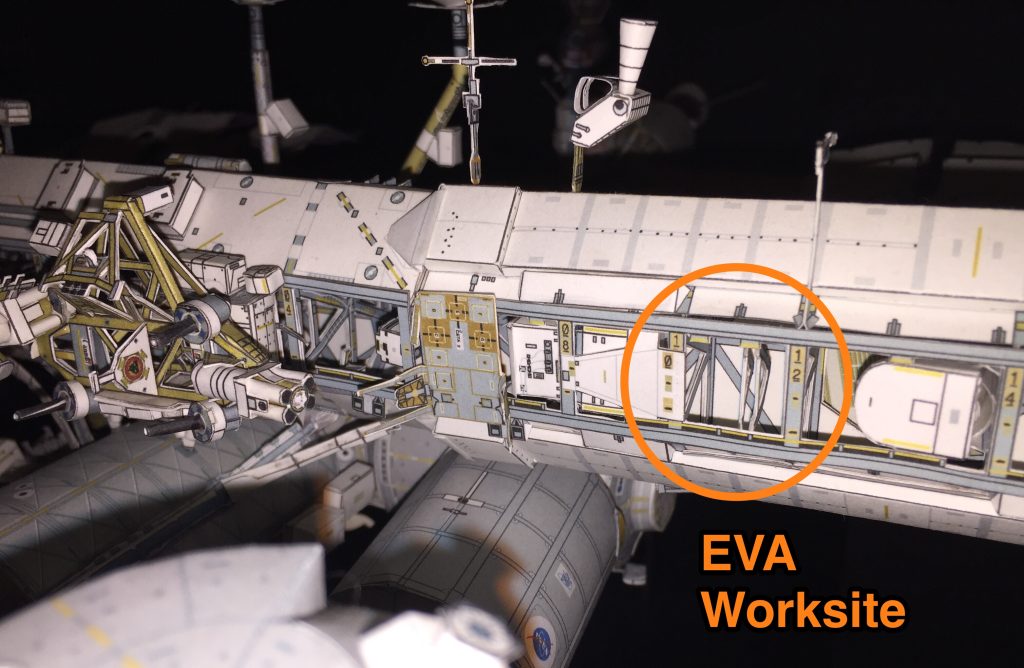EVA and the Soviet Manned Lunar Mission Plan (1969)
In 1991 the Soviets revealed the plan for piloted lunar flight they developed in the 1960s to counter Apollo. EVA was to have made up for launch vehicle and docking system shortfalls. The EVA technologies developed for lunar exploration are significant today because they still shape Russian EVA.

Because he was alone on the moon, the lunar cosmonaut was outfitted with an EVA suit that was entirely self-donning and contained unusual features to ensure his safety.
The Zvezda organization, which builds Russian pressure suits, states that research into semi-rigid and rigid suit designs began in 1962. Work on the semi-rigid Kretchet (“gyrfalcon”) lunar surface EVA suit and its orbital EVA counterpart, Orlan (“eagle”) commenced at Zvezda in 1967. Both suits had a hard aluminum alloy torso with integral helmet, soft fabric arms and legs, and an innovative door-like rear hatch. The hatch cover took the form of a backpack containing the suit’s life support equipment. There were no external hoses between the backpack and the suit, as in Apollo. The hatch concept is attributed to Zvezda engineer Anatoli Stoklitskii.
The flight engineer entered the LOK orbital module, donned a liquid-cooling garment which included a head covering, and slipped into his Kretchet suit. The mission commander donned his Orlan suit, which lacked Kretchet’s waist and hip joints. Orlan had a “simplified” outer thermal insulation and micrometeoroid protection layer and a single metal-coated green sun visor (Kretchet had two visors, at least one of which was gold-coated).
The commander depressurized the orbital module, then the flight engineer egressed and crawled back along the LOK using handholds and handrails. The commander stood by in the orbital module in case the flight engineer had difficulties. He entered the LK through a hatch in the protective shroud and took his place behind the controls. Then the mission commander fired pyrotechnic bolts to separate the LOK from the LK/D Block stack and the shroud from the LK.
The D Block engine restarted for LK descent to the lunar surface. About 1.6 km (1 mi) above the surface the D Block exhausted its fuel and fell away. The LK fuel supply gave the flight engineer only 1 min of hover time for locating a landing spot. Because of Kretchet elbow and shoulder joint mobility constraints, the flight engineer flew the LK using a special “finger controller.”
Immediately after touchdown the flight engineer prepared for a 4-hr lunar surface EVA. The suit’s Kaspy (“Caspian”) regenerative life support system, built into Kretchet’s hatch door, was designed for 10 hr of operation. He depressurized the LK cabin, opened the inward-opening oval LK hatch (so shaped to accommodate the Kretchet’s bulging rear hatch) and climbed to the surface. He immediately attached a hoop to his waist behind him. The hoop was designed to roll him onto his front so he could regain his feet if he fell on his back. The flight engineer remained close to the LK as he collected surface samples, planted the Soviet flag, and posed for a TV camera.
Some sources state that the cosmonaut would have climbed out of Kretchet and rested after returning to the LK. He then fired the LK’s engine (the same one used for final approach and landing) and returned to orbit. The LOK and LK used a simplified docking system called Kontakt, which was very tolerant of docking misalignments, but had no provision for IVA transfer. The LOK probe snagged any of the 108 hexagonal holes in a “honeycomb” plate atop the LK. After docking, the flight engineer transferred by EVA back to the LOK, carrying with him the samples he collected on the lunar surface. Again the mission commander stood by in the LOK orbital module inside his Orlan suit in case the flight engineer had difficulties during the EVA.
